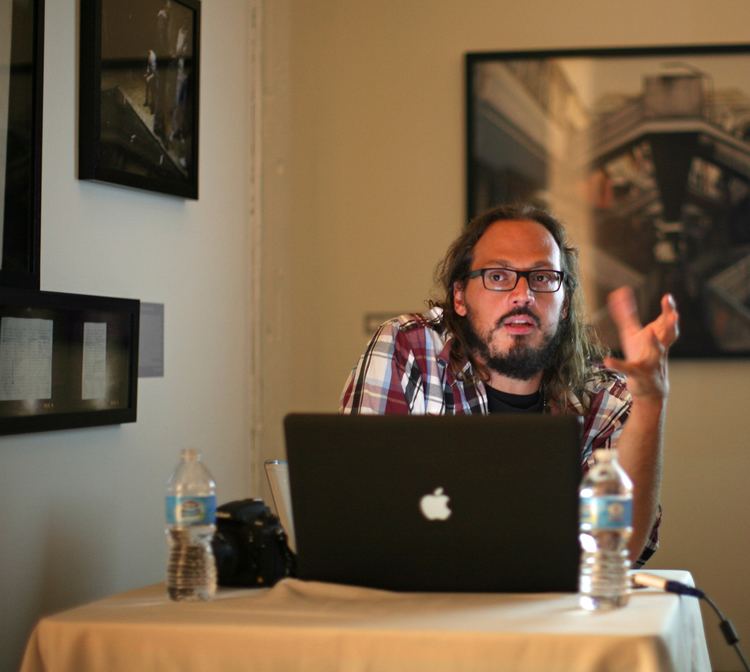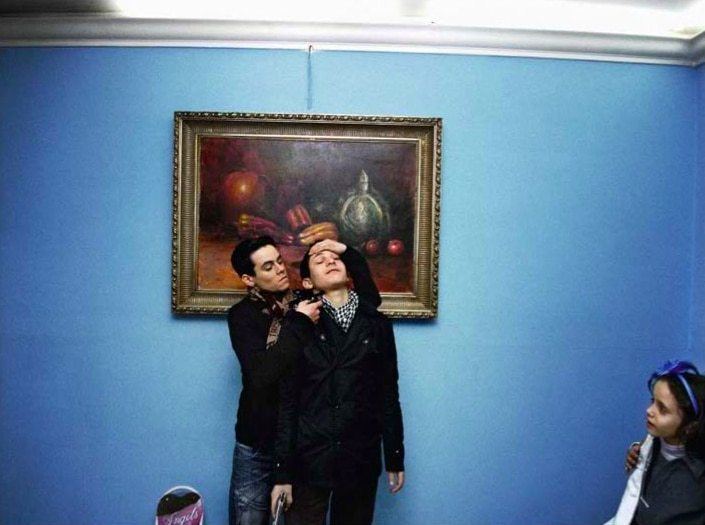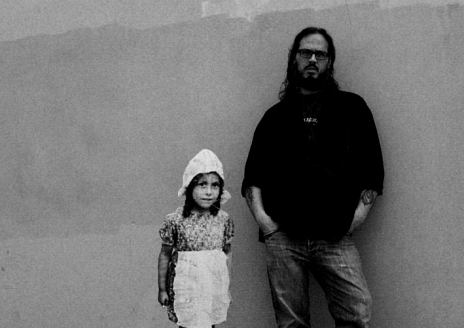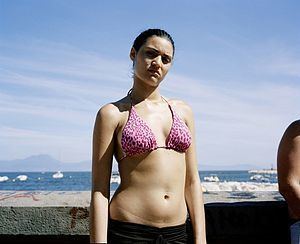Known for Gomorrah Girl Books Gomorrah Girl Alma mater University of Bologna | Role Photographer Name Valerio Spada | |
 | ||
Born 1972 Milan, Italy Awards Guggenheim Fellowship for Creative Arts, US & Canada | ||
Valerio spada editor publisher
Valerio Spada (born 1972) is an Italian photographer best known for his book Gomorrah Girl. In 2013 he was awarded a Guggenheim Fellowship for Creative Arts, Photography. The Fellowship was awarded in support of his work exposing the hardships of those living in the impoverished parts of Italy. Previous Guggenheim Fellows include Robert Frank, Cindy Sherman, John Gossage, Edward Weston and Diane Arbus. His work has been exhibited internationally, including in the US and Europe.
Contents
- Valerio spada editor publisher
- Interview photographer valerio spada discusses gomorrah girl with stated magazine
- Early life and career
- Overview
- Personal experiences during the project
- Recognition
- Exhibitions
- References

Interview photographer valerio spada discusses gomorrah girl with stated magazine
Early life and career

Valerio Spada was born in Milan, Italy, in 1972. He attended Universitá degli Studi di Lettere e Filosofia in Bologna, Italy, for his undergraduate work and graduated with an MFA in Photography in 1996 from Istituto Italiano di Fotografia in Milan, Italy. In 2013 Spada was awarded a Guggenheim Fellowship in the Creative Arts, Photography category, for the pursuit of his photographic projects in the poorer neighborhoods of Italy.
Overview

In 2011 Spada self-published his first book, Gomorrah Girl. It was later re-published in its third edition by Twin Palms Publishers. According to Slate Magazine Spada's inspiration, "in the form of Giovanni Durante, a strong-willed man who had lost his 14-year-old daughter to a mafia feud. She had been standing in front of his small store, chatting with a 22-year-old man. It turns out that this 22-year-old man was a mafia boss, due to be assassinated. As a motorcycle approached and opened fire on the young boss, he returned the fire, accidentally killing the young girl as she fled. Over the coming months Valerio spent his time trying to understand the life of young Annalisa. He wandered her hangouts, pored over police notebooks, and visited mafia meeting places, consumed with the story of a girl he’d never met."

Slate continues, writing, "The book combines pages of police notebooks, photos of people and locations connected to the case, and portraits of other young women from the area. Many of these women are not explicitly connected to the story and at first it’s confusing why they are in the book at all. Presented looking directly into the camera in their loud bikini tops and sparkly shirts, they make it seem as if an amateur fashion shoot accidentally fell into a police file. The viewer is forced to ask how the girls are related to the documents from the case, and this is exactly what Spada wants."

Spada has described the subject of the book as, "the problems of becoming a woman in a dangerous, crime ridden area. Adolescence is almost denied, at 9 they dance, move and make themselves up as tv personalities and dream to become one of them. At 13 or 14, very often, they become mothers, skipping the adolescence which is lived fully everywhere else in Italy." The areas mainly photographed were the la Vela Rossa and la Vela Blu neighborhoods of Naples. Stated Magazine reviewed the book, writing, "As one reads and rereads Gomorrah Girl, these matte pages, made of a much thinner, coarser stock, become worn and creased, so that they come to resemble more and more the actual police document. Conceived in collaboration with Dutch graphic artist Sybren Kuiper, this design feels a bit awkward at first—for example, one has to turn the book sideways in order to look at Spada’s pictures—but one quickly sees how appropriate and chillingly effective it is. Layering Spada’s photos over top of reproductions of crime scene pics and other forensic evidence serves to remind us again and again of the backdrop of crime and violence against which the girls of the Naples projects become young women. It’s as if Spada’s photos are part of the Durante evidentiary record or perhaps are being saved in its pages for inclusion one day in a similar police document. Any one of the girls who Spada photographs could easily meet with the same fate as Annalisa Durante."
Personal experiences during the project
Stated, chronicling Spada's own experiences in these neighborhoods while putting together the book, wrote further that, "Throughout the Gomorrah Girl project Spada himself was never far from danger. Not surprisingly, the Comorra—the Neapolitan mob who control the housing estates—were less than enthusiastic to have a photographer in their midst and initially tried to bully Spada off of their turf, although he persisted and eventually became a familiar and mostly accepted figure.
"However, after taking what may be Gomorrah Girl’s most shocking photograph, an image of one young woman shooting up in the basement of a former kindergarten, Spada only narrowly escaped a beating and probably worse. Alerted to what he was up to by the shutter sound and red focusing beam of his camera, a group of junkies quickly surrounded Spada and, furious over his intrusion, started manhandling him. Somewhat miraculously, the local man who had led Spada to the basement managed to defuse the situation, and Spada escaped unharmed. It was at that moment, however, that he knew the project was at an end."
Recognition
Gomorrah Girl was the Grand Prize winner of the 2011 Photography Book Now competition and accompanying $25,000 prize. The prize was announced in Time Magazine, which wrote, "The story comes together in the books innovative design—Spada’s own documentary photographs, along with a smaller book of photographs detailing the police investigation, are bound together. Captions offer details into the personal tragedies suffered by the subjects alongside stone-cold factual information provided by police evidence."
Spada was also nominated for book prizes including the best photography book of the year at the International FotoBook Festival in 2012 and artist of the year at the Albert Renger-Patzsch Awards in 2012. Spada won the Festival della Fotografia in Rome 2011 as best project. His exhibitions include those hosted by MACRO, Museum of Contemporary Art in Rome, Italy. Photos from the book Gomorrah Girl are part of the collections at the George Eastman House, International Museum of Photography and Film, Cleveland Museum of Art, the ICP International Center of Photography.
Exhibitions
Spada's first American solo exhibition profiling the photographs take during the Gomorrah Girl project was in September through November 2012 at the PPAC Phila Photo Arts Center in Philadelphia, and was shown in Madrid, Spain from January to April 2013. It has also been shown in the Netherlands, France, and Italy. The Philadelphia Inquirer reviewed the exhibition, writing, "Disaffected young women in minuscule bikinis look into Spada's camera with diffident expressions; in what appears to be a museum gallery, two teenage boys standing in front of a still-life painting stage a frighteningly realistic gangland-style execution with handguns while a little girl looks on with a slight smile. Young heroin addicts slump on stairs and in doorways. Perhaps not surprisingly, Spada's images of plucky pubescent girls who have probably not yet gotten caught up in the sex and drug trades are even more disturbing. Despite Spada's use of color and his clearly contemporary subjects, his pictures quickly recall the harsh poverty of post-World War II Italian life as portrayed in Italian neorealist films of the 1940s and 1950s, by Vittorio De Sica, Roberto Rossellini, Luchino Visconti, and others. Sadly, this cast of characters is all too real." El Pais wrote that they found uneasiness and distress in the subjects of the exhibition, highlighting in particular the photograph of "Sabrina", an eleven-year-old girl who performs songs of mourning at mafia gatherings and personal events. In 2017 Valerio Spada's "I am nothing" is exhibited at Camera, Centro Italiano per la Fotografia in Turin from March to May 2017 in a show curated by Francesco Zanot and in a parallel opening with "L'Italia di Magnum" in occasion of 70th year anniversary of Magnum Agency. The two exhibitions are meant to give different point of views on Italy.
